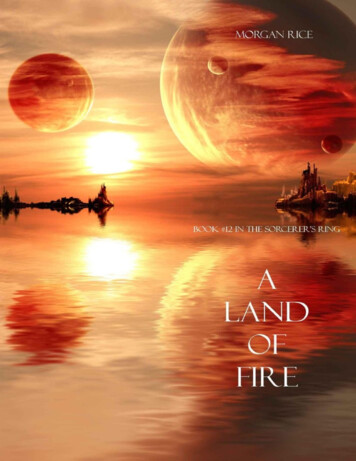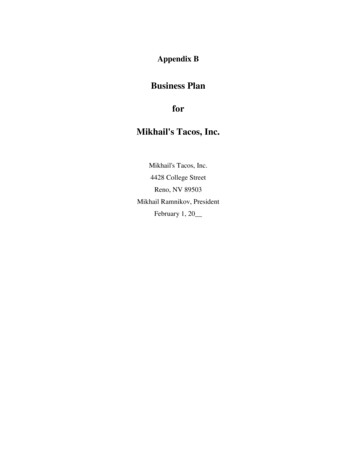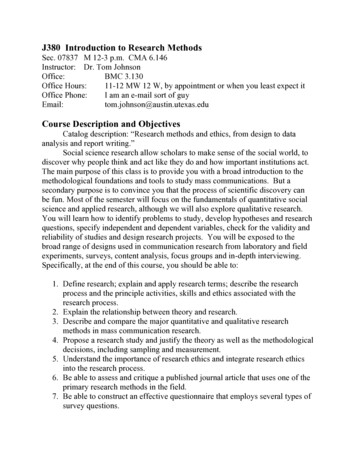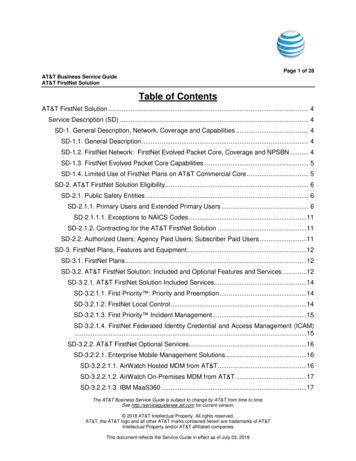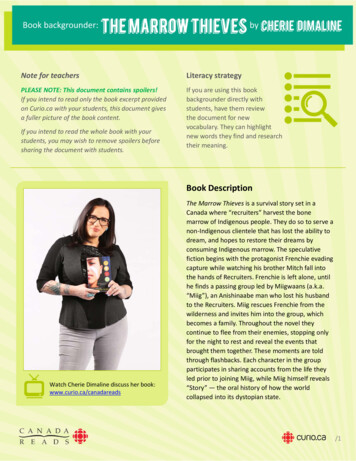
Transcription
Note for teachersLiteracy strategyPLEASE NOTE: This document contains spoilers!If you intend to read only the book excerpt providedon Curio.ca with your students, this document givesa fuller picture of the book content.If you are using this bookbackgrounder directly withstudents, have them reviewthe document for newvocabulary. They can highlightnew words they find and researchtheir meaning.If you intend to read the whole book with yourstudents, you may wish to remove spoilers beforesharing the document with students.Book DescriptionWatch Cherie Dimaline discuss her book:www.curio.ca/canadareadsThe Marrow Thieves is a survival story set in aCanada where “recruiters” harvest the bonemarrow of Indigenous people. They do so to serve anon‐Indigenous clientele that has lost the ability todream, and hopes to restore their dreams byconsuming Indigenous marrow. The speculativefiction begins with the protagonist Frenchie evadingcapture while watching his brother Mitch fall intothe hands of Recruiters. Frenchie is left alone, untilhe finds a passing group led by Miigwaans (a.k.a.“Miig”), an Anishinaabe man who lost his husbandto the Recruiters. Miig rescues Frenchie from thewilderness and invites him into the group, whichbecomes a family. Throughout the novel theycontinue to flee from their enemies, stopping onlyfor the night to rest and reveal the events thatbrought them together. These moments are toldthrough flashbacks. Each character in the groupparticipates in sharing accounts from the life theyled prior to joining Miig, while Miig himself reveals“Story” — the oral history of how the worldcollapsed into its dystopian state./1
Along the way, they meet other Indigenouscharacters, some of whom betray them and otherswho help them reunite with some of the groupmembers they lose. Frenchie comes across afamiliar face among these strangers when he findshis father. Shortly thereafter, they head to theresidential school where Minerva, an elderlymember of Miig’s entourage, was being heldcaptive. After her ancestral singing overpowers hercaptors and destroys the school, Minerva isrelocated. During the group’s second rescueattempt, they fail to save Minerva and she dies froma bullet wound.The novel ends with Frenchie finding Isaac, Miig’shusband whom many presumed dead, among agroup of survivors, inspiring Frenchie to neverabandon hope: “And I understood that as long asthere are dreamers left, there will never be want fora dream” (p. 231).Primary CharactersFrenchie. The novel’s Métisprotagonist and first‐person narrator.At 16, he has lost his brother, Mitch,and his mother to Recruiters. He presumes he hasalso lost his father until they meet again towardsthe conclusion of the novel. He cannot resist theallure of Rose, another group member, and theybecome inseparable at the end of the story. Anotherturning point for Francis comes at the moment hekills Travis to avenge RiRi’s death at his hands.Rose. Frenchie’s love interest. She joins the groupshortly after him when group members catch hertrailing them. Rose comes from the White Riverreserve and grew up with her grandmother after herparents were captured. Her grandmother’s brothertaught her to hunt. Together with Frenchie, shehelps Miig find Isaac.Miigwaans (also known as Miig). One of the twogrown‐ups in the group. He believes he lost hishusband, Isaac, to the authorities at a residentialschool, but they meet once again at the very end ofthe novel. Miig introduces the younger members ofthe group to Story, an account of the events leadingup to the post‐apocalyptic world they know.Minerva. The group’s elder. Throughout most of theplot, she remains silent except when she teachesRose words in her native language. In anotherinstance, she uses her voice and song to cause amarrow‐extracting machine to break. She diescaught in gunfire from the Recruiters.Chi‐Boy. A Cree 17‐year‐old member of the group.Tree and Zheegwon. The 12‐year‐old twins of thegroup.Slopper. A nine‐year‐old group member from theEast Coast.Wab. An eighteen‐year‐old member of the group.She is also a rape survivor.RiRi. A seven‐year‐old Metis girl and the group’syoungest member. She stands in for the readers,offering Frenchie pragmatic advice. Herstrangulation by a pair of imposters in the group,Lincoln and Travis, leads Frenchie to kill one of herattackers.Isaac. Miig’s Cree husband. He is found by Frenchieand later reunited with Miig./2
Frenchie’s father. Frenchie believes he lost hisfather, but meets him towards the last third of thenovel. He was living near Espanola among anIndigenous council. He lost his wife to the marrowextraction program.Recruiters. A type of truancy police that capturesIndigenous people and extracts their marrow toacquire their dreams. They hold prisoners inresidential schools and their hierarchy resemblesthat of the Catholic church.Travis and Lincoln. Bounty hunters that infiltrate thegroup secretly, but are ultimately abandoned oncetheir motives become apparent (pg. 132). In astandoff, Travis strangles RiRi and is shot by FrenchieThe EndingAt the end of the novel, Miig and Isaacreunite as Frenchie and Rose vow to keepeach other company as they move through Ontario’swilderness as a group.Key ThemesINDIGENOUS KNOWLEDGEIn The Marrow Thieves, non‐Indigenous peoples tryto commodify the knowledge Indigenous folkspossess, above all the ability they have to dream.Minerva’s knowledge as an elder is particularlyvaluable and brings about the destruction of one ofthe Recruiters’ “schools” where captives are housedand their marrow is harvested. These schools are inturn a symbol of Canada’s history of trying toappropriate Indigenous knowledge, whileassimilating (and often killing) Indigenous people.BODIESIn the hostile setting of The Marrow Thieves, bodiesare the last resource characters have. They are minedby recruiters for the marrow that stores dreams, butthey also serve as repositories of memories. Minervapersonifies this function as the keeper of languageand Indigenous song. Bodies also carry indeliblemarks of violence. Wab reveals to her fellow travelersthat the scars on her face came from an encounterthat resulted in her rape (pg. 85). Having to carry anexternal reminder of this episode turns a wrongdoinginto a lifelong injury. Psychologically, it alsodebilitates Wab as she gives up running, havingpreviously depended on this skill to earn her living asa messenger. Wab's body is a living reminder of thesuffering she has endured. Memory by way of thebody is both a gift and a curse.THEFTThe theft of Indigenous marrow is, of course, centralto The Marrow Thieves, but the nomadic group alsohave to contend with the theft of the security andstability they once knew. Living in a constant state ofuncertainty and fear alters the way charactersembody their Indigenous identities. The MarrowThieves depicts weary travellers who seem resignedto living as prey. The moment Frenchie decides toabandon the security his father offers in favour oftravel with Rose illustrates the degree to which hehas embraced a life of peril (pg. 218). They remainon the run because they have been robbed of landand forced into this existence./3
Contextual information Cherie Dimaline is a Georgian Bay Métis author. The Marrow Thieves is Dimaline’s fourth book. The novel won both the 2017 Kirkus Prize for YoungReaders' Literature and the 2017 GovernorGeneral's Literary Award for Young People'sLiterature – Text.Notable Quotes fromReviews“Though the novel tackles some heavy subject matter,The Marrow Thieves feels lighter as a result ofDimaline’s graceful, almost fragile, prose. Dimalinethrusts readers into the complex lives of rich andnuanced characters forced to navigate a world thattoo closely resembles our own. At first glance, thebook appears to be dystopian fiction swarming withadventure and danger; however, readers with aninterest in social justice and a grasp on colonial historywill extract much deeper meaning. The book is, aboveall, a cautionary tale, revealing an exaggerated versionof what could happen to Earth in the not‐so‐distantfuture. It is a timely and necessary read referencingpipelines, melting northern territories, rising waterlevels, and the consequences of government policiesthat don’t protect the environment. Powerful andendlessly smart, it’s a crucial work of fiction for peopleof all ages.”– Jessica Rose, Quill & QuireCBC / Other LinksThe message YA novelist CherieDimaline has for young Indigenousreaders (CBC Books: How I Wrote It blog post):http://cbc.ca/1.4195036What gets Cherie Dimaline through the tough partsof writing (CBC Books: Magic 8 questionnaire):http://cbc.ca/1.4391668How Cherie Dimaline found hope in a dystopianfuture (The Next Chapter interview):www.cbc.ca/1.4313264Cherie Dimaline: Hopes and dreams in theapocalypse (Toronto �the‐apocalypse.htmlCherie Dimaline: ‘My community is where mystories come from and it’s also where myresponsibilities lie’ (The Globe and 6/"The Marrow Thieves is speculative fiction with achilling immediacy. Its unflinching narrativeresonates in our disturbing times. Cherie Dimaline’sexceptional writing and authentic characters pullyou into a story that lingers and unsettles."– Governor General's Literary Awards peerassessment committee/4
Critical Thinking QuestionsActivitiesStudents may need to do someresearch to help them create andorganize an answer.1. Students can create aKWL (i.e. Know, Want toKnow, Will Look/Learn)chart on the subject ofIndigenous peoples in Canada.1. Look at the title of the novel. What could thestory be about?2. What can a novel about an undesirable futuretell us or emphasize for us about the world welive in today?3. The theme of dreamers is a major theme in thisnovel, and it is reflected in this quote: “And Iunderstood that as long as there are dreamersleft, there will never be want for a dream”(p. 231). Who are the dreamers of today? Whatare their dreams?4. The Marrow Thieves explores the idea that ourphysical bodies serve as a storage for ourmemories. What are the strengths andweaknesses of the human body?5. Who is Cherie Dimaline? Why do you think shehas written this story?6. How is the future depicted in The MarrowThieves informed by the actual history ofIndigenous peoples in North America?2. Teachers can invite an Indigenous communitymember into the classroom. For example, a FirstNations or an Inuit elder, or Métis senator.Teachers should ask the invited speaker aboutany protocols they would like to have observedduring the visit. Many schools boards have anIndigenous education resource lead orconsultant, and teachers can contact thisindividual to ask for advice and help inorganizing such an endeavour.3. Students should be introduced to the followingterms: Indigenous, First Nations, Métis, Inuit,Residential Schools and Colonization.4. Working in pairs, students can create an interviewfor one of the characters. One student can take onthe role of the interviewer and create thequestions, and the partner can answer thequestions in the role of the character.5. Students can create a T‐Chart outlining positiveand negative impressions of the content in thebackgrounder, as well as any questions thebackgrounder inspires them to ask./5
tell us or emphasize for us about the world we live in today? 3. The theme of dreamers is a major theme in this novel, and it is reflected in this quote: “And I understood that as long as there are dreamers left, there will never be want for a dream” (p. 231). Who are the dreamers of today?File Size: 815KBPage Count: 5
![[Type here] - Sigmund Freud:Theories,Biography,Quotes,Free .](/img/19/the-ego-and-the-id.jpg)

